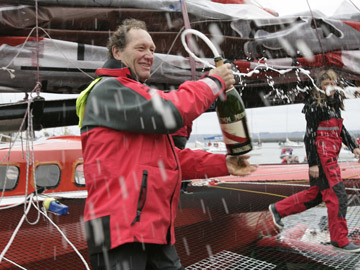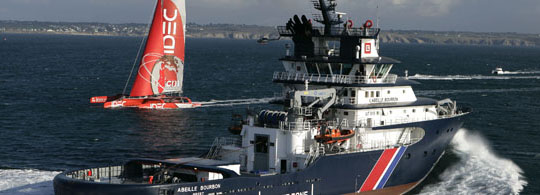 |
The Official
|
| www.sailing.org |

JOYON's voyage encompassed 26,000 nautical miles of excitement covered at an average speed of 19.09 knots, 4 knots better than Ellen MACARTHUR (GBR), whose record has been improved upon by two whole weeks. Here is a summary in three acts of this extraordinary ocean adventure.
Act I: Gliding All The Way To Tasmania
JOYON set sail from Brest on Friday 23 November 2007 at 11:05, in a northeasterly flow, which reached 25 knots at the tip of Brittany. To beat MACARTHUR's record, IDEC had to complete her circumnavigation in less than 71 days, 14 hours and 18 minutes, or in other words return before the 3 February 2008 at 01:23. Easily recognizable with her very long central hull, the Irens/Cabaret design immediately put on the speed, respecting precisely the battle plan that had been drawn up beforehand with the router, Jean-Yves BERNOT: a gybe in the Bay of Biscay and then work hard to keep up the speed all the way to the trade wind.
 |
| © JEAN MARIE LIOT/DPPI/IDEC |
JOYON thought it would take him eight days to reach the Equator. However, from the outset, he achieved averages of 22 knots covering 500 miles per day and passing all the marks: Cape Finisterre on the first day, getting through the Azores and Madeira on the second and swallowing up the Canaries on the third and Cape Verde on the fourth… "The weather opportunity was really good," the skipper was pleased to announce, never finding enough words to praise at the same time the way his boat handled the seas.
At this intense pace, IDEC crossed the Equator on Friday 30 November, after six days and a little under 18 hours: two days better than MACARTHUR and ten hours less than Orange II with her crew in the Jules Verne Trophy! When we remember that the first goal was "Not to waste too much time over Ellen's first stretch"…
After ten days of sailing, hardly slowed down by the Doldrums, on 3 December, IDEC was already off Rio de Janeiro, with a lead of 800 miles. They then had to go and find a small low-pressure centre, which would open the route to the Cape of Good Hope. IDEC was to find the way through and hurtled into the South Atlantic in a northerly flow, on the edge of the Saint Helena high. The short cut was amazing. The red arrow cut through the roaring forties at an average speed of 25 knots. We were looking forward to an incredible time to the Cape of Good Hope and were not disappointed: on 8 December, IDEC rounded the stormy cape in 15 days, 7 hours and 16 minutes at an average speed of 20.12 knots! Her lead rose to four days.
Galloping ahead of a low-pressure area, IDEC tackled the Indian at full speed: 560 miles, then 600 miles in one day! The pace achieved by the quiet man was that of a crew and on 12 December, near the Kerguelens, with the albatrosses as witnesses, JOYON beat the 24-hour solo speed record: 616 miles at an average speed of 25.66 knots (a record improved upon to 619 miles by Thomas COVILLE a few weeks later). On Sunday 16 December, IDEC reached Cape Leeuwin, in the South of Australia seven days ahead of the record. On Tuesday 18 December, to the south of Tasmania, JOYON smashed the Indian Ocean record in 9 days and 12 hours, or three days better than MACARTHUR and only 59 minutes more than Orange II.
"With some rabid dogs snapping at your heels, you go faster," joked JOYON. However, things were to be very different in the Pacific.
Act II: A Pacific That Put Up A Fight
In fact, after speeding along at the front of a low there was now a high threatening to becalm JOYON in his crossing of the third ocean, the badly named Pacific. To the south of New Zealand, he was already down at 54 degrees south, on some mountainous seas under heavy black clouds threatening heavy rain and gale force winds, which forced him to manoeuvre out and find the best way through all the time in order not to get stuck.
On the 27th day of racing, IDEC was already at the halfway point. However, in order to keep up high average speeds and escape from the calms, he had to go down further and further, thus approaching the areas, where the icebergs were drifting around. JOYON's Christmas was a little special. Sailing under stormsail, IDEC went through hell: 40, 45 then 50 knots, nasty seas, 7-metre waves breaking, all as he made his way through the minefield of icebergs. A good reason to get angry with nature, but that is not JOYON's style.
 |
| © Francis Joyon |
JOYON, the ecologist sent a message "to all the children, who want to share my dream" for his next message: "I realize now that the planet isn't as big as all that. Previous generations thought it was infinite and drew on its resources, but we have now reached a key moment. The world still possesses all its beauty, but for the first time, man can put an end to that, if we are not careful. I believe children understand that better than adults, who are often too deeply involved in their daily lives to see what is going on. Only the children can wake them up and make them understand that the main thing is to allow the birds to fly in the forests, the bears to wander around the pack ice, the dolphins to surf on the waves of the oceans and in the end, for man to live in harmony with his planet."
To find the right bearing in the Pacific, IDEC had to go right down to 59 degrees south, while the ice alert was at 52°. However, he was to be rewarded after taking this route imposed on him by the weather conditions. On Saturday 29 December, at 23:31, IDEC reached the Horn. The toughest Cape in just 35 days! Yet another amazing achievement averaging 21 knots on the route he actually covered. His lead over MACARTHUR was now nine and a half days. Now time for something easier? We can never be suspicious enough of that climb back up the Atlantic…
Act III: The Climb Back Up With All Its Dangers
After Tierra del Fuego, the slowdown was extremely sudden. Becalmed, sailing upwind - "twice the distance to cover and three times the effort required," - IDEC was forced to zig-zag up the coast of Argentina. No more days of 500 miles on the clock. He had to make do with 300 or even less.
Initially, on the fortieth day of sailing, JOYON managed to take advantage of a corridor of wind, which was a little less unfavourable between a high and a low. But from 4-8 January, the South Atlantic proved herself to be without mercy. The wind continued to blow from the north head on, forcing the Breton skipper to change tack over and over again. The trimaran was badly shaken up in some rough seas.
"I suffer, when I see my boat suffering," sighed JOYON, who was sorry to have lost Thomas COVILLE (FRA), who had been chasing after him to grab the same record, before being forced to retire following damage off South Africa. For JOYON, the only thing on his mind now was picking up the easterly trade wind, which would allow him to get the clocks back up to speed again. On 8 January, he managed this. On 9 January the speedo went back up above 20 knots and in spite of his port rudder being blocked (which he quickly repaired), the boat rose up on one float and sped off to the Equator. The line separating the two hemispheres was crossed again on 10 January in 48 days, 2 hours and 18 minutes… 12 and a half days ahead of the record!
However, on the next day, JOYON thought he had hit the worst. The mainsail halyard gave up the ghost and when he went up the mast to repair it, JOYON discovered some much more serious damage: the shaft holding the starboard shroud in place was coming unscrewed. If it came off, it would mean he would dismast. Fifty days of efforts could be reduced to nothing in a fraction of a second.
The suspense was unbearable: will it hold out or not? JOYON injured his ankle climbing back up his mast, not just twice, but three times, 32 metres above cross seas. Under reduced sail, and selecting a more suitable route, to ease the tension on the shroud - a position, where he was less likely to see it break off - IDEC managed however to continue on her way.
 |
| © LIOT-VAPILLON/DPPI/IDEC |
On 14 January, JOYON said, "It's a bit tough, as the boat is now very tired." A master of understatement, as there was more damage to come. Sailing upwind in 28 knots of wind, the staysail stay gave out, a block made a hole in the deck… it was war, still with the sword of Damocles hanging over him in the shape of this shroud, which could fail at any moment.
It was extremely hard on the nerves up until Wednesday 16 January, when JOYON managed to climb back up IDEC's mast for a fourth time and hammer for all his life the broken part to ensure it remained in place. The operation was successful and confidence returned to the red trimaran. There were then the dangers of a very deep depression to avoid in the Bay of Biscay to achieve a remarkable feat in Brest: 57 days, the record shattered by 14 days. Two whole weeks. JOYON was already a very great sailor. It probably will not please him, but today he has become an icon, whom kids will look up to. Mr Francis JOYON, a living legend.
Major Dates
- Start from Brest: Friday 23 November 2007 at 11:05:52
- Crossing the Equator (outward): Friday 30 November at 04:03 in 6 days, 17 hours and 58 minutes. Two days ahead of Ellen MACARTHUR
- Cape of Good Hope: Saturday 8 December at 18:21, in 15 days, 7 hours and 16 minutes. Four days ahead.
- 24-hour record on Wednesday 12 December 2007: 616.07 miles at an average speed of 25.66 knots. Since improved to 619.3 miles by Thomas COVILLE.
- Cape Leeuwin: Sunday 16 December. Seven days ahead.
- Indian Ocean Record (South of Tasmania): Tuesday 18 December in 9 days, 12 hours and 3 minutes. Record improved by three days.
- Cape Horn: Saturday 29 December at 23:31 in 35 days, 12 hours and 31 minutes. Nine and a half days ahead
- Crossing the Equator (homeward run): Thursday 10 January at 13:23 in 48 days, 2 hours and 18 minutes. Twelve days and 11 hours ahead.
- Finish in Brest: Sunday 20 January 2008 at 00:39:58, in 57 days, 13 hours, 34 minutes and 6 seconds. Record beaten by 14 days, 44 minutes and 27 seconds. Around 26,400 miles covered at an average speed of 19.09 knots on the water.
Record History
- Francis JOYON, IDEC. 2008. 57 days, 13 hours, 34 minutes and 6 seconds
- Ellen MACARTHUR, B&Q. 2005. 71 days, 14 hours, 18 minutes and 33 seconds
- Francis JOYON, IDEC. 2004. 72 days, 22 hours, 54 minutes, 22 seconds
The Record To Beat
Record: Round the World, non-stop, singlehanded
Yacht: B&Q
Skipper: Ellen MACATHUR (GBR)
Dates: 28 November 2004-7 February 2005
Elapsed time: 71 days, 14 hours, 18 minutes and 33 seconds
Distance: 21,760 nm
Average Speed: 12.66 knots
Trimaran IDEC - http://www.trimaran-idec.com/
World Sailing Speed Record Council - http://www.sailspeedrecords.com/

















.png)